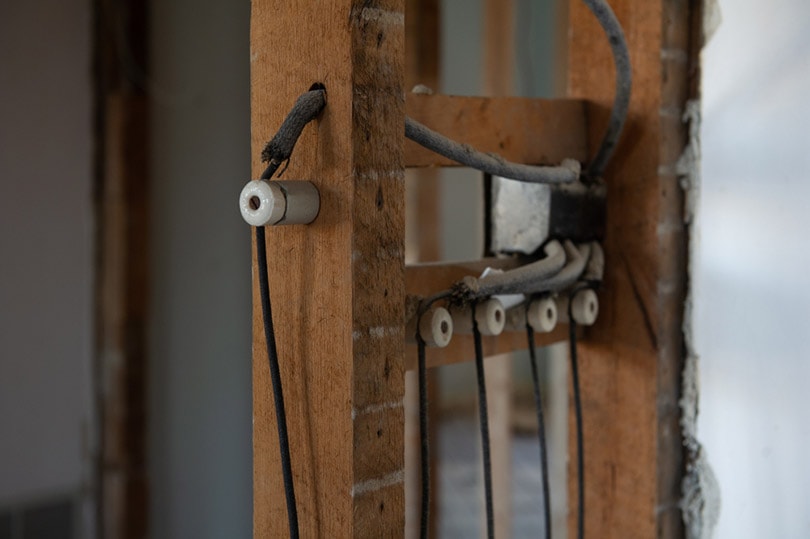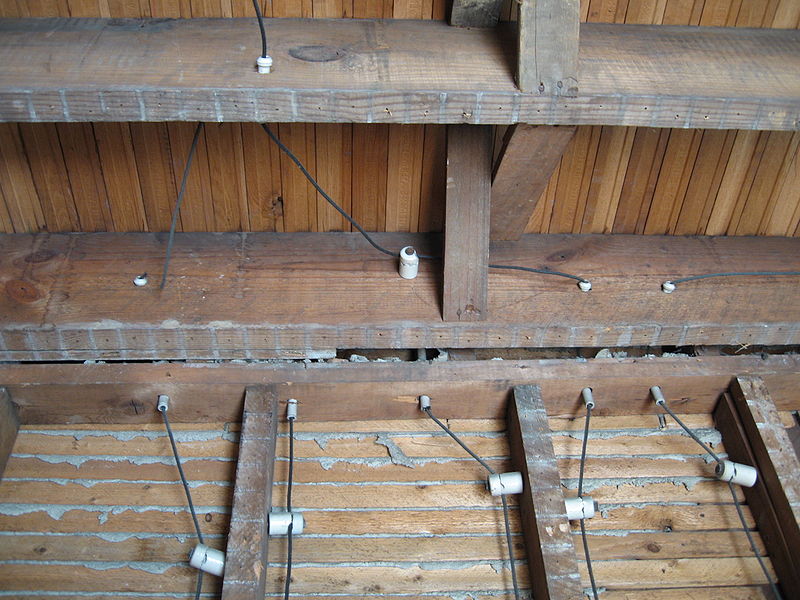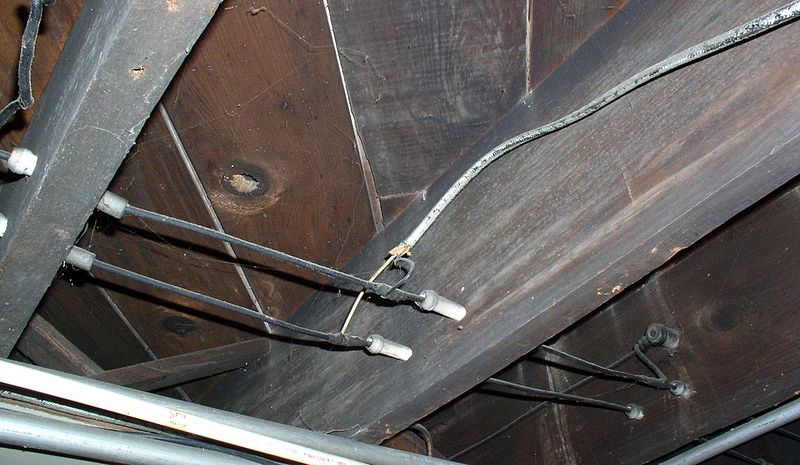How Much Does It Cost To Replace Old Knob and Tube Wiring? Facts & FAQ
-

- Last updated:

Knob and tube wiring was the most common form of home electricity from 1880 until 1950. Knob and tube were some of the earliest forms of residential wiring ever produced. That being said, it is no surprise that knob and tube wiring is no longer desirable in modern homes as it does not pass modern building code, it can be a fire hazard, and the old wiring can even be a threat to modern electronics.
If you own a home from this timeframe and have never had the electrical system updated, you might be looking at a full replacement to switch out the knob and tube system with modern wiring.
What Is Knob and Tube Wiring?
Knob and tube is the name of very old wiring systems. Also known as K&T, knob and tube wiring utilized insulated copper wiring that was threaded between protective porcelain knobs. The wiring ran in the ceiling or attic cavities and was threaded inside or on interior walls. The wiring was extremely primitive and had no functional grounding component making the system vulnerable to shorts and discharge.
Knob and tube began being gradually replaced in the 1930s before being completely phased out by 1950 in favor of more modern electrical systems. Finding old knob and tube wiring today is rare, but it does still happen. Knob and tube wiring is found in homes built prior to 1950, especially homes built between 1900 and 1930.

The Importance of Healthy Electrical Wiring
Knob and tube wiring is outlawed in new construction today except for under extremely specific circumstances that usually involve in-depth historical restoration. That is because knob and tube wiring lacks the solid insulation that modern wiring has. This makes knob and tube wiring prone to shorts and even fire. Electrical fires are one of the most common ways that residential buildings burn down. Knob and tube wiring also lacks a good grounding system which can exacerbate these dangerous problems.
Ensuring that you have an electrical system that is functioning properly is key to the long-term health of your home. Bad wiring is extremely dangerous, and it can be very costly. In order to ensure that your house is up to code and safe, it might be necessary to fully replace and upgrade your old knob and tube wiring system.
The cost of such a replacement varies based on a variety of factors, but it can be extremely expensive in some cases.
How Much Does It Cost To Replace Old Knob and Tube Wiring?
The cost of a complete knob and tube replacement can vary greatly based on a number of factors including the size of the home, the age of the home, and the location of the home. Larger houses that have more wiring to replace will be more expensive than small houses. The location of the wires themselves also plays a huge role in the cost. If the wires are easily accessible, the cost will be much less than if the wires are buried in the walls or behind concrete.
The only way to know the exact cost is to get a professional estimator to come and look at your home. However, the average cost of a typical two-story home runs around $9000 on average.
| Major Market | Average Cost | Minimum Cost | Maximum Cost |
| New York City | $10,344 | $1,293 | $19,395 |
| Los Angeles | $8,576 | $1,072 | $16,080 |
| Chicago | $9,168 | $1,146 | $17,190 |
| Miami | $8,056 | $1,007 | $15,105 |
| Houston | $9,112 | $1,139 | $17,085 |
- Source: Inchcalculator.com
Small jobs with wiring that is easy to locate and access can be as low as $1,000 but large jobs in areas with a lot of codes or building requirements could get as high as $19,000. It is hard to nail down an exact cost because every house is different, and unlike other jobs, electrical replacement varies greatly by a large number of unique factors.
Knob and tube replacement is considered a large job and it is wise to anticipate significant costs when starting the project.

Additional Costs to Anticipate
One of the highest costs to anticipate when doing a knob and tube replacement job is going to stem from inspections. Whenever a home’s electrical system is replaced, it will need to be inspected by the city to ensure it meets local codes. Inviting an inspector into your home can often yield unwanted surprises. Electrical panel replacement, smoke detector regulations, and grounding wire placement are all things that inspectors look for when going over a home’s electrical system. Adjustments, delays, or additional work can quickly add to the cost of any job.
The worst part about these hidden costs is that inspectors leave the homeowners’ hands tied. Jobs cannot be completed without the sign-off of inspectors, which eliminates the ability for homeowners to choose to delay certain critical aspects of the job even if it is more expensive than anticipated.
It is also important to pay attention to whether or not your electrician will replace drywall after the job is finished. Not all electricians will fix holes or replace drywall that had to be removed in order to get to your home’s wiring. Some electricians will do the work but they charge extra for it. This is an important detail to note. If your electrician will not replace your drywall, you will have to find another contractor to come in behind the electrician after the inspection and fix the drywall, or you will be left with holes in your wall.
How Often Should I Update My Home’s Electrical System?
The good news is that a home’s electrical system should rarely have to be replaced in its entirety. Knob and tube wiring has to be replaced because, in some cases, it is a hundred years old. Newer systems should be able to last the lifetime of your home without having to do any serious work.
Systems might need to be replaced if they fail. Failing electrical systems can happen due to faulty wiring, lightning strikes, or a bad electrical panel. However, these issues are relatively rare and can often be avoided by regular maintenance and by paying attention to the behavior of your home.
Should I Get My Home’s Wiring Inspected?
Electrical inspections are not common, but they do happen. You do not need to schedule an inspection on your own unless you are having major issues. Electrical systems get inspected when a home is sold, after a large electrical job, or every ten years. If you are not having any issues and you are not planning on selling your home, you only need to schedule an inspection every ten years to ensure that everything is running smoothly.
Barring those few rare occasions, you should not have to get your home’s wiring inspected.
What To Do If You Suspect You Have Faulty Wiring
Any wiring can fail over time. The common signs that you might have faulty wiring or a ground fault are if your power cuts out in good weather, flickering lights, buzzing sounds when things power on, or breakers that frequently trip. If you have one or multiple of these symptoms there could be something wrong with your electrical system. If you have a home that was built prior to 1950 it could be the result of old and dangerous knob and tube wiring.
The best course of action is to call a local electrician to come out and inspect your system. They will be able to determine what the status of your home’s electrical system is and what kind of repair is needed. Local electricians will also be able to schedule inspections, pull permits and deal with the city in the case of a large repair.
Final Thoughts
Knob and tube wiring is a relic of the past. It is not compatible with many of today’s modern electronics and the presence of knob and tube wiring can be inconvenient and even dangerous. If knob and tube wiring become an issue a full replacement will likely become necessary. Costs will run in the thousands of dollars but the repairs are necessary to keep your home safe and healthy for many years to come.
Featured Image Credit: Alessandro Cancian, Shutterstock
Contents


